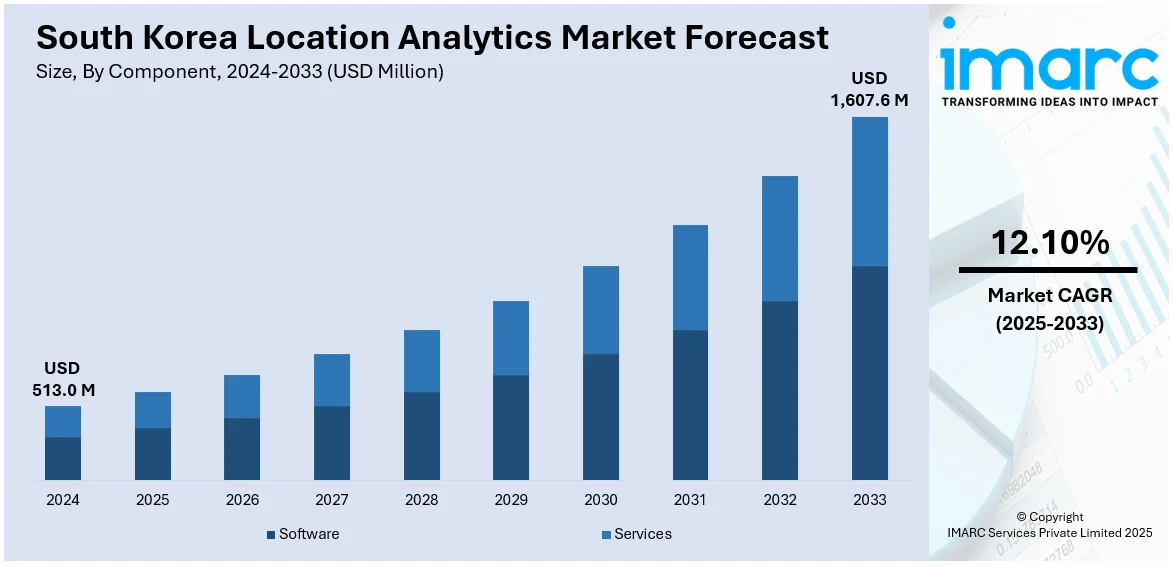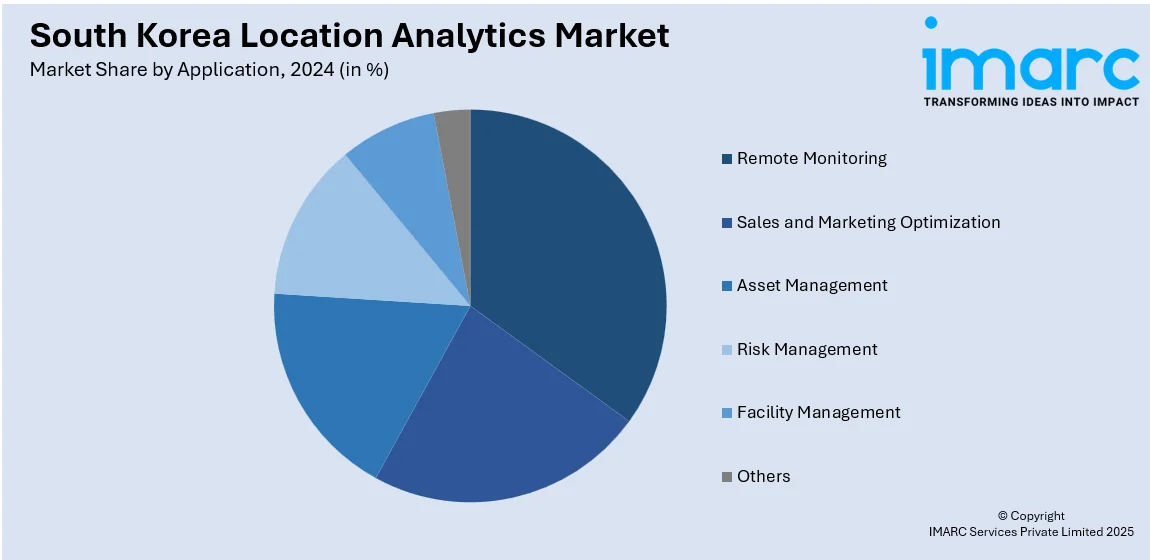
South Korea Location Analytics Market Size, Share, Trends and Forecast by Component, Deployment Mode, Location Type, Application, End-Use Industry, and Region, 2025-2033
South Korea Location Analytics Market Overview:
The South Korea location analytics market size reached USD 513.0 Million in 2024. The market is projected to reach USD 1,607.6 Million by 2033, exhibiting a growth rate (CAGR) of 12.10% during 2025-2033. The market is growing due to rising adoption of AI-driven spatial tools and real-time data platforms. In addition, expanding cloud infrastructure and smart city initiatives continue to support South Korea location analytics market share across transportation, public safety, and infrastructure development applications.
|
Report Attribute
|
Key Statistics
|
|---|---|
|
Base Year
|
2024
|
|
Forecast Years
|
2025-2033
|
|
Historical Years
|
2019-2024
|
| Market Size in 2024 | USD 513.0 Million |
| Market Forecast in 2033 | USD 1,607.6 Million |
| Market Growth Rate 2025-2033 | 12.10% |
South Korea Location Analytics Market Trends:
Rising Demand for High-Speed Processing
The growing need for faster data interpretation and real-time decision-making has fueled investment in large-scale AI infrastructure, directly impacting the South Korea location analytics market growth. Industries such as logistics, transportation, and urban development are increasingly relying on high-speed processing capabilities to manage location-based datasets and enhance operational efficiency. As spatial data becomes central to applications like traffic monitoring, smart infrastructure, and automated delivery systems, real-time processing is now a necessity rather than an option. For instance, in February 2025, South Korea revealed plans to construct a 3GW AI data center by 2028, aimed at supporting advanced data processing and regional network connectivity. The facility is expected to generate USD 3.5 Billion in annual revenue and serve millions of users, acting as a core infrastructure node for handling intensive AI and geospatial workloads. This development marks a strategic move to support location-based services with faster computing and improved access to analytics tools. By building such infrastructure, the country is laying the groundwork for advanced spatial data solutions that can process and analyze real-time location inputs with minimal latency. As the reliance on geospatial systems grows, sectors ranging from mobility tech to emergency services are expected to benefit from improved processing capabilities, driving continued market growth.

To get more information on this market, Request Sample
Infrastructure Expansion for Spatial Intelligence
Infrastructure development tailored to AI and cloud technologies is reshaping the potential of Location Analytics in South Korea. With geospatial tools requiring high-capacity back-end systems, the expansion of data centers plays a vital role in enabling smarter, location-based services. Location Analytics depends on reliable infrastructure to analyze satellite data, urban activity, and regional shifts in real time capabilities only possible through strong digital foundations. For example, in June 2025, SK Group and AWS announced a USD 5.11 Billion investment to develop an AI data center in Ulsan, equipped with 60,000 GPUs. With 41MW capacity in its first phase by 2027 and future scaling up to 103MW by 2029, the project aims to be South Korea’s largest domestic data center, transforming Ulsan into a new digital hub. This development supports AI-powered spatial applications and ensures scalability for future expansion. As the demand for intelligent spatial systems accelerates, this kind of infrastructure helps unlock real-time geolocation intelligence for sectors like public safety, climate response, and autonomous systems. It reduces reliance on fragmented systems by centralizing compute power, enabling faster location-based analysis. The result is a stronger, AI-integrated Location Analytics market, aligned with South Korea’s digital innovation strategy.
South Korea Location Analytics Market Segmentation:
IMARC Group provides an analysis of the key trends in each segment of the market, along with forecasts at the country and regional level for 2025-2033. Our report has categorized the market based on component, deployment mode, location type, application, and end-use industry.
Component Insights:
- Software
- Services
The report has provided a detailed breakup and analysis of the market based on the component. This includes software and services.
Deployment Mode Insights:
- On-premises
- Cloud-based
A detailed breakup and analysis of the market based on the deployment mode have also been provided in the report. This includes on-premises and cloud-based.
Location Type Insights:
- Indoor
- Outdoor
The report has provided a detailed breakup and analysis of the market based on the location type. This includes indoor and outdoor.
Application Insights:

- Remote Monitoring
- Sales and Marketing Optimization
- Asset Management
- Risk Management
- Facility Management
- Others
A detailed breakup and analysis of the market based on the application have also been provided in the report. This includes remote monitoring, sales and marketing optimization, asset management, risk management, facility management, and others.
End-Use Industry Insights:
- BFSI
- Healthcare
- Hospitality
- Government
- Transport and Logistics
- IT and Telecom
- Retail and Consumer Goods
- Media and Entertainment
- Others
The report has provided a detailed breakup and analysis of the market based on the end-use industry. This includes BFSI, healthcare, hospitality, government, transport and logistics, IT and telecom, retail and consumer goods, media and entertainment, and others.
Regional Insights:
- Seoul Capital Area
- Yeongnam (Southeastern Region)
- Honam (Southwestern Region)
- Hoseo (Central Region)
- Others
The report has also provided a comprehensive analysis of all the major regional markets, which include Seoul Capital Area, Yeongnam (Southeastern Region), Honam (Southwestern Region), Hoseo (Central Region), and others.
Competitive Landscape:
The market research report has also provided a comprehensive analysis of the competitive landscape. Competitive analysis such as market structure, key player positioning, top winning strategies, competitive dashboard, and company evaluation quadrant has been covered in the report. Also, detailed profiles of all major companies have been provided.
South Korea Location Analytics Market News:
- July 2025: Seegene launched STAgora, a real-time infectious disease analytics platform combining diagnostics with geospatial modeling. It advanced South Korea’s location analytics market by offering location-based outbreak tracking and predictive insights, improving public health response through precise regional disease visualization and data-driven interventions.
- June 2025: Alibaba Cloud launched its second data center near Seoul to expand AI and cloud capacity. This development supported South Korea’s location analytics industry by improving data processing speed, reliability, and service availability for spatial intelligence across enterprise and government applications.
South Korea Location Analytics Market Report Coverage:
| Report Features | Details |
|---|---|
| Base Year of the Analysis | 2024 |
| Historical Period | 2019-2024 |
| Forecast Period | 2025-2033 |
| Units | Million USD |
| Scope of the Report |
Exploration of Historical Trends and Market Outlook, Industry Catalysts and Challenges, Segment-Wise Historical and Future Market Assessment:
|
| Components Covered | Software, Services |
| Deployment Modes Covered | On-premises, Cloud-based |
| Location Types Covered | Indoor, Outdoor |
| Applications Covered | Remote Monitoring, Sales and Marketing Optimization, Asset Management, Risk Management, Facility Management, Others |
| End-Use Industries Covered | BFSI, Healthcare, Hospitality, Government, Transport and Logistics, IT and Telecom, Retail and Consumer Goods, Media and Entertainment, Others |
| Regions Covered | Seoul Capital Area, Yeongnam (Southeastern Region), Honam (Southwestern Region), Hoseo (Central Region), Others |
| Customization Scope | 10% Free Customization |
| Post-Sale Analyst Support | 10-12 Weeks |
| Delivery Format | PDF and Excel through Email (We can also provide the editable version of the report in PPT/Word format on special request) |
Key Questions Answered in This Report:
- How has the South Korea location analytics market performed so far and how will it perform in the coming years?
- What is the breakup of the South Korea location analytics market on the basis of component?
- What is the breakup of the South Korea location analytics market on the basis of deployment mode?
- What is the breakup of the South Korea location analytics market on the basis of location type?
- What is the breakup of the South Korea location analytics market on the basis of application?
- What is the breakup of the South Korea location analytics market on the basis of end-use industry?
- What is the breakup of the South Korea location analytics market on the basis of region?
- What are the various stages in the value chain of the South Korea location analytics market?
- What are the key driving factors and challenges in the South Korea location analytics market?
- What is the structure of the South Korea location analytics market and who are the key players?
- What is the degree of competition in the South Korea location analytics market?
Key Benefits for Stakeholders:
- IMARC’s industry report offers a comprehensive quantitative analysis of various market segments, historical and current market trends, market forecasts, and dynamics of the South Korea location analytics market from 2019-2033.
- The research report provides the latest information on the market drivers, challenges, and opportunities in the South Korea location analytics market.
- Porter's Five Forces analysis assists stakeholders in assessing the impact of new entrants, competitive rivalry, supplier power, buyer power, and the threat of substitution. It helps stakeholders to analyze the level of competition within the South Korea location analytics industry and its attractiveness.
- Competitive landscape allows stakeholders to understand their competitive component and provides an insight into the current positions of key players in the market.
Need more help?
- Speak to our experienced analysts for insights on the current market scenarios.
- Include additional segments and countries to customize the report as per your requirement.
- Gain an unparalleled competitive advantage in your domain by understanding how to utilize the report and positively impacting your operations and revenue.
- For further assistance, please connect with our analysts.
 Request Customization
Request Customization
 Speak to an Analyst
Speak to an Analyst
 Request Brochure
Request Brochure
 Inquire Before Buying
Inquire Before Buying




.webp)




.webp)












